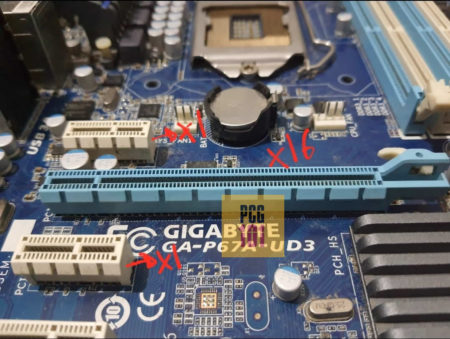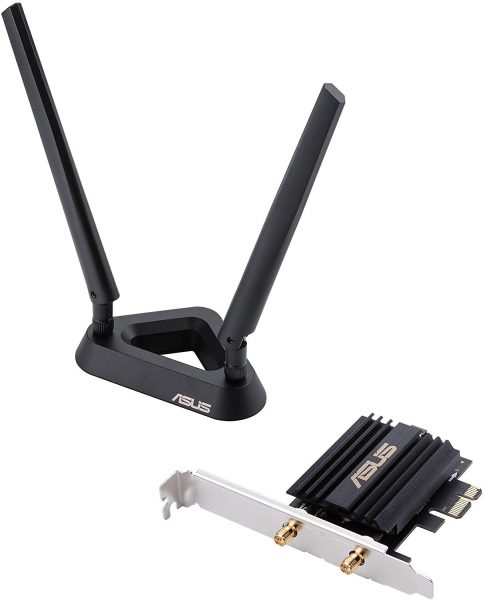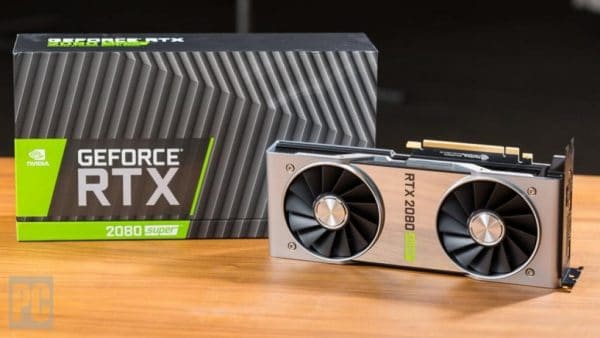A wireless card requires only a PCIe x1 slot – which also happens to be the smallest in physical size and throughput rate.
This is because even the newest WiFi 6 PCIe cards have a throughput (speed) of about 2.4 Gbps (300 MB/s) on a 5 GHz frequency. Contrast this to the data rate of a single PCIe x1 slot that can handle a throughput rate of 985 MB/s and 1969 MB/s on PCIe version 3.0 and 4.0, respectively!
This article discusses which PCIe slot for wireless cards is most suitable. In doing so, we will look into why that is so and talk about PCIe slots, version, bandwidth, and all the related jargon.
If you are looking for a simple answer, then the PCIe x1 slot is the one to go for. Currently, no PCIe wireless card is powerful enough to leverage the bandwidth of a higher PCIe lane count; hence, none require a larger PCIe slot.
Let us look into PCIe Wireless Card, PCIe Lanes, and PCIe Slots.
TABLE OF CONTENTS
PCIe Lanes, Bandwidth, Version, and Slots
You must understand some PC jargon to understand why a PCIe x1 slot is sufficient for a WiFi card.
A PCIe lane is like a highway through which data travels to and fro the slot. The more lanes a PCIe slot has, the higher would be the throughout rate (speed in layperson’s terms) of the expansion card that attaches to it.
The more demanding an expansion card is, the more PCIe lanes it requires.
The throughput rate of each lane differs from generation to generation.
| Version | x1 (GB/s) | x2 (GB/s) | x4 (GB/s) | x8 (GB/s) | x16 (GB/s) |
|---|---|---|---|---|---|
| 1.0 | 0.250 | 0.500 | 1.000 | 2.000 | 4.000 |
| 2.0 | 0.500 | 1.000 | 2.000 | 4.000 | 8.000 |
| 3.0 | 0.985 | 1.969 | 3.938 | 7.877 | 15.754 |
| 4.0 | 1.969 | 3.938 | 7.877 | 15.754 | 31.508 |
| 5.0 | 3.938 | 7.877 | 15.754 | 31.508 | 63.015 |
| 6.0 | 7.877 | 15.754 | 31.508 | 63.015 | 126.031 |
Table: PCIe version and lane throughput.
The table above shows that the throughput of a single PCIe lane, x1, is 0.50 GB/s on PCIe v.2. However, a single PCIe x1 v3.0 lane has a 0.985 GB/s throughput.
Different PCIe slot sizes have an additional amount of PCIe lanes.
Standard sizes include x1, x4, x8, x16.

It is essential to understand that the amount of PCIe lanes in your system has been limited. Hence it is wise to understand the lane requirement of new cards and the overall you have available.
For instance, if you have 20 PCIe lanes in your system and have a graphics card taking up 16 routes, and an M.2 expansion card taking four lanes, you would not be able to install an additional WiFi card to a free x1 slot.
Also Read:
- How to Check How Many PCIe Lanes I Have
- How to Check How Many PCIe Slots I Have
- PCIe 3.0 vs. 2.0 – PCIe Versions Explained
So Which PCIe Slot for Wireless Card?

As mentioned earlier, the x1 slot is more than enough for the contemporary WiFi 5 and WiFi 6 protocols.
Why is x1 Sufficient for a Wireless Card?
This has all to do with the bandwidth requirement of the WiFi card. The bandwidth requirement of a WiFi 6 card does not even saturate a single PCIe 2.0 lane, let alone that of versions 3.0 and 4.0.
The transfer speed of the PCIe slot differs from version to version. Currently, the most common PCIe version is version 3.0. However, on older or entry-level motherboards, you may also find some slots operating at Version 2.0.
As the table above shows, PCIe Version 3.0 has a transfer speed of about 1 GB/sec per lane. This is sufficient to support the transfer speed requirement for the wireless add-in cards. Why? Let us look at an instance:
An average PCIe WiFi 6 card promises a speed of 2.4 Gbps on 5 GHz frequency. 2.4 GigaBITS per second equals 300 MegaBYTE per second. Note the difference between bits and bytes. They are NOT the same thing.
As we saw earlier, a PCIe x1 v2.0 slot has a speed of 500 MB/s; likewise, PCIe x1 v3.0 caps at 985 MB/s and PCIe x1 v4.0 at 1969 MB/s.
So while the ancient PCIe x1 v1.0 with its 250 MB/s throughput rate cap may not be sufficient to handle the newer gen WiFi 6 speed to its max capability, the rest of the generations of PCIe slots are more than enough to manage WiFi 6 cards.
Also Read: Onboard WiFi vs. WiFi Card vs. WiFi USB
Cross Compatibility
It should be noted, however, that while ideally, an x1 slot should be used, you CAN fit the Wireless card in other larger slots, i.e., the x4, x8, or even the x16.
But you should also note that installing the WiFi card in a larger PCIe slot will not give it any performance boost.
Plus, doing so would mean you must sacrifice a larger PCIe slot that can otherwise be used for more extensive and demanding expansion cards like RAID controllers or SSD expansion cards.
For instance, a PCIe x16 is the largest slot on a consumer-grade motherboard. If you occupy that with a WiFi card that requires a mere x1 slot, you will have wasted a card that can be used for a graphics card instead.
Also Read: Can I Use a PCIe 3.0 Card in a 2.0 Slot?
Do You Need to Provide External Power to the Wireless Card?
No, you do not. Unlike the graphics cards installed on a PCIe x16 slot that requires direct PSU power, the WiFi card does not.
WiFi cards consume very little power and can be powered through the PCIe slot.
A PCIe slot itself can provide 75 Watts of power.
Making Sure You Have Enough PCIe Lanes
This is a critical consideration when installing newer PCIe devices to your computer.
Every PC has only a limited amount of PCIe lanes. Using the PCIe x1 slot means using one PCIe lane of your computer.
The total amount of PCIe lanes is determined by the processor you have and your motherboard chipset.
You can find out how many lanes you have by looking at the processor and the motherboard chipset spec sheet.
To install a WiFi Card and make it work, you must have one PCIe lane available.
An Example

Image: NVIDIA RTX 2080. Graphics Cards can take 16 Lanes.
As mentioned earlier, your number of PCIe lanes is limited, so you must be careful when building your system and procuring newer expansion cards like a WiFi card.
Typically an average processor offers 16 PCIe lanes, and the motherboard may offer four or more. So let’s say you have 20 PCIe lanes available to you.
Say you install a graphics card on an x16 slot and a RAID controller on an X4 slot. They both will occupy 16 and 4 lanes, respectively, totaling 20.
Hence, even if you have a free X1 slot, installing a WiFi card will not allow it to work since all the total lanes you have are already in use.
On the other hand, if you only have a single graphics card installed and nothing else, you can use the X1 slot for your WiFi card. With this configuration, you will have occupied 17 out of 20 lanes (16 for graphics card and 1 for WiFi card).
Therefore, you will still have 3 PCIe lanes available, which can be used for other devices.
In short, you must manage your total PCIe lanes and the number of expansion cards you install.
Also Read: Do Motherboards Have Bluetooth?
Final Words
Here we looked at a common question asked by those new to PCIe configuration and expansion cards, i.e., which PCIe slot for a wireless card is suitable?
The most straightforward answer is the x1 slot, and we looked at the reason why above. However, if you do NOT have an x1 slot available, you can install the WiFi card in x4, x8, or even on an x16 slot, but you will not see any performance boost.
Again before installing any PCIe expansion card like the WiFi card, you must ensure your PC has enough PCIe lanes to support your card.
This is especially true if many devices are connected to your motherboard. In case you have no device attached, or if you only have a single graphics card associated, there is high certainty that you will have enough PCIe lanes left to support the WiFi expansion card without any issue.
FREQUENTLY ASKED QUESTIONS
1. Can I install a wireless card in any available PCIe slot on my motherboard?
No, not all PCIe slots on a motherboard are designed for the same purpose. The PCIe slots may differ in terms of their speed and size.
Therefore, it is essential to check your motherboard’s user manual to identify which PCIe slot is compatible with your wireless card.
2. Are there any performance differences between using different PCIe slots for my wireless card?
Yes, there may be differences in performance when using different PCIe slots for a wireless card. The speed of the PCIe slot can affect the data transfer rate, which may impact the overall performance of the wireless card.
Therefore, it is important to use the appropriate PCIe slot for your wireless card to ensure optimal performance.
3. Is it possible to install multiple wireless cards in different PCIe slots on the same motherboard?
Yes, it is possible to install multiple wireless cards in different PCIe slots on the same motherboard. However, the number of available PCIe slots and their compatibility with the wireless cards will depend on the specific motherboard model.
Therefore, it is recommended to check the motherboard user manual to ensure compatibility and proper installation.
Additionally, it is important to consider any potential interference between multiple wireless cards and to ensure that they are configured correctly.

I have a question, my mobo is an gigabyte b460m ds3h, i was using an rx 480 in the pci-e x16 slot and my wifi in the first pci-e x1 slot, all working fine until i bought an rtx 3070ti wich doesn’t allow me to connect to the first pci-e x1 where my wifi card was before, so i moved it down to the second x1 pci and now the connection is all clunky, speed may vary and isnt stable. Is this normal? thanks for reading this.
No as far as the performance goes, it should not matter whether you use the first x1 slot or the second x1 slot.
You are an excellent teacher. Clear, precise & succinct. Thank you.
Thank you for your kind comment. Glad you found the article helpful.
Hi Dear Atif
I was reading my motherboard (Asus Prime Z270-A) manual to see which PCIe-x1 out of four available to install new internal Wi-Fi&Bluetooth card (ASUS PCE AX-3000) on it. Because of it’s double bulky long antennas I prefer to use the slot number 4 which is the lowest one in order to keep it far from motherboards back panel. there I observed a table with this title :
IRQ assignments for this motherboard
first column including : PCIe x16_1, PCIe x16_2 … Intel LAN1(i219) … HD Audio, ASMedia 2142
And first row : A, B, C, …, H
The table shows some of these information above have shared.
My questions are:
1.What does these A to B refer to?
2. and at the moment I’m not using a separate VGA card but soon I will use a single one, So would there be any risk of intrupt or confilict between these two cardd and if so how to prevent it using the suitable slots?
That would be very kind of you to reply and help with these qestions
Hi Desasus,
I wouldn’t worry too much about the IRQ Table. They have more or less become obsolete for PC builder since more than 2 decades or so. It basically defines the interrupt request prioritization which you can read about if you are a student of computer systems, for fun, or if you are working for ASUS, but if you are building a PC this should be of no concern to you :).
As for your second question, there would be no conflict when using your VGA card in the x16 slot and Wireless card in the fourth x1 slot.
P.S: the “A, B” refers to the group name. Had you asked the question more than two decades ago then yes installing a WiFi card in the fourth x1 slot that shared the IRQ group with the Intel LAN1(i219) would have been an issue, but it is not with the modern motherboard architecture and OS.
Thank you so much for your response and useful information
Thank you, this was a very useful article for understanding compatibility between WiFi 6 cards and PCIe x1 ports.
Hi Dear Atif
My motherboard is a ASUS PRIME B360M-A (300 Series) Intel LGA-1151 and my adapter is FebSmart Wireless N Dual Band 600Mbps PCIE WiFi Adapter. Would it be alright to be using either PCIe x1 ports on the motherboard? The GPU (MSI Gaming GeForce GTX 1660 Super 192-bit HDMI) I have is blocking the first one and I’m concerned its the problem stopping the wifi adapter from working.